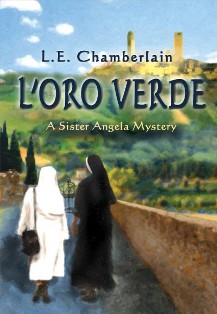Bookstore
AMATEUR SLEUTH/
RELIGIOUS/TRAVEL/
SENIOR SLEUTH MYSTERY
RELIGIOUS/TRAVEL/
SENIOR SLEUTH MYSTERY
L'oro verde
Read A Review:
Sister Angela appears to be part of a monastic order in Tuscany where obedience and poverty aren’t part of the traditional vows. Good thing for her, since the local police detective, who gives her a special cell phone to keep in touch, needs her help to solve crimes. Sister can’t always rely on getting immediate permission from Mother Margherita or the bishop to transfer her teaching duties to her fellow sister and admirer, Sister Daniela, and travel to interview suspects.
The Green Gold of the title refers to the rich olive oil industry of the region of Italy where a brutal murder takes place. Chamberlain begins the story with an unusual and halting eyewitness account of the crime through the eyes of the victim. A host of unsympathetic suspects and unwitting players make it difficult to know who to root for, who to boo. Chamberlain places little vignettes of conversation and scenes throughout the story, weaving a tale that eventually comes together for the “aha” moment. What was the secret behind the mentally deficient young man who worked in the olive oil factory? Who was his mysterious girlfriend, but more importantly, what did he learn that led to his death?
Sister Angela’s quick conclusions and interview tactics leave little room for the reader to enjoy the journey of figuring out means and motives. As Chamberlain said, could murder happen in such a romantic setting (as the Tuscan hills)? I would have loved to have spent more time in the scenery than on bus rides and dusty streets headed toward the nearest dim church or factory.
Several previous cases are mentioned in the story. Since I couldn’t find any other Sister Angela mysteries, I assumed this might be the first. I hope the author will take a step back at some point and let us grow with Sister Angela from the beginning of her venture into police work.
Lisa Lickel
Sister Angela appears to be part of a monastic order in Tuscany where obedience and poverty aren’t part of the traditional vows. Good thing for her, since the local police detective, who gives her a special cell phone to keep in touch, needs her help to solve crimes. Sister can’t always rely on getting immediate permission from Mother Margherita or the bishop to transfer her teaching duties to her fellow sister and admirer, Sister Daniela, and travel to interview suspects.
The Green Gold of the title refers to the rich olive oil industry of the region of Italy where a brutal murder takes place. Chamberlain begins the story with an unusual and halting eyewitness account of the crime through the eyes of the victim. A host of unsympathetic suspects and unwitting players make it difficult to know who to root for, who to boo. Chamberlain places little vignettes of conversation and scenes throughout the story, weaving a tale that eventually comes together for the “aha” moment. What was the secret behind the mentally deficient young man who worked in the olive oil factory? Who was his mysterious girlfriend, but more importantly, what did he learn that led to his death?
Sister Angela’s quick conclusions and interview tactics leave little room for the reader to enjoy the journey of figuring out means and motives. As Chamberlain said, could murder happen in such a romantic setting (as the Tuscan hills)? I would have loved to have spent more time in the scenery than on bus rides and dusty streets headed toward the nearest dim church or factory.
Several previous cases are mentioned in the story. Since I couldn’t find any other Sister Angela mysteries, I assumed this might be the first. I hope the author will take a step back at some point and let us grow with Sister Angela from the beginning of her venture into police work.
Lisa Lickel

